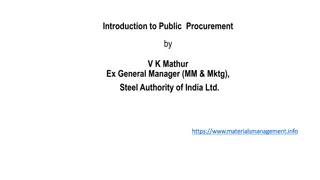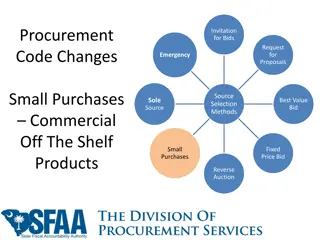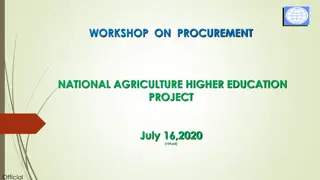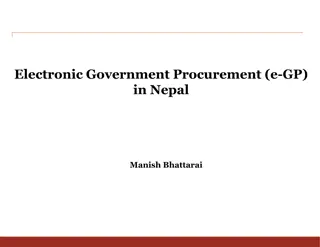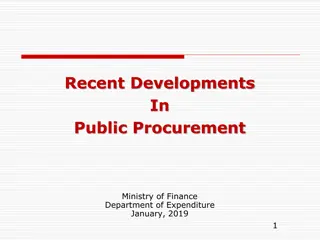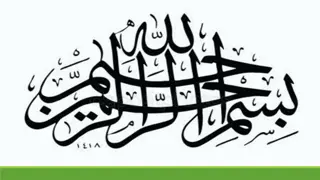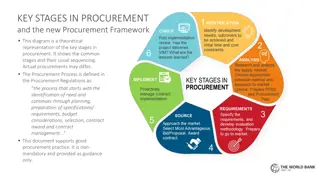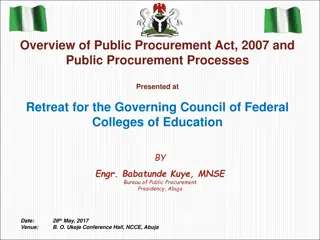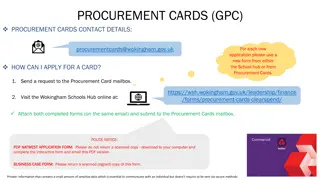Evolution of E-Procurement System in Macedonia
The e-Procurement system in Macedonia has evolved significantly since its initial development in 2008, with the launch of a web-information system for publishing contracts. The process of integration of various functionalities, setup, and development of the new integrated system have been crucial steps. The system covers tendering, evaluation, e-auction, notification, e-invoicing, e-payment, and complies with relevant EU legislation. Extensive trainings have been conducted for users, enhancing the efficiency of public procurement in the country.
Download Presentation

Please find below an Image/Link to download the presentation.
The content on the website is provided AS IS for your information and personal use only. It may not be sold, licensed, or shared on other websites without obtaining consent from the author.If you encounter any issues during the download, it is possible that the publisher has removed the file from their server.
You are allowed to download the files provided on this website for personal or commercial use, subject to the condition that they are used lawfully. All files are the property of their respective owners.
The content on the website is provided AS IS for your information and personal use only. It may not be sold, licensed, or shared on other websites without obtaining consent from the author.
E N D
Presentation Transcript
e-Procurement system in Macedonia - e-government application with an impact -
INITIAL DEVELOPMENT 2008 - launch of a web-information system (WIS) for publishing contract 2006-2007 period for extensive development, testing and pilot 2005 Initial idea through USAID eGov Project technical 2008-2009 Parallel functioning of WIS and e-Procurement system in Macedonia notices/notifications (implemented through the Public Procurement Bureau) procurements; Legal basis for e-procurement provided specifications prepared according to the PP process of a pilot institution Although increased usage of the two systems potential problems of parallel functioning!! need for integration Mandatory usage of WIS all CA s are obliged to publish their CN s and CAN s on this website 01.01.2008 fully fledged e-PP system installed Public section of all published notices and notifications End of 2007 new Law on PP adopted modifications to the system made detailed technical instructions prepared solution Consortium of 2 local IT companies selected to develop the software 2005 2006/2007 2008 2008/2009
PROCES OF INTEGRATION oglasi-izvestuvanja.finance.gov.mk https://www.e-nabavki.gov.mk Kept functionalities of the two systems @ Improved and upgradedfunctionalities @ https://e-nabavki.gov.mk
SETUP AND DEVELOPMENT OF THE NEW INTEGRATED SYSTEM Prepared Action Plan for e-Procurement Preparatory phase - development of the functional requirements, development of the application (phase programming and modeling), testing Promotion of the new integrated system as well as the e-procurement as a field of public procurement Manualswith instructions on how to use the EPPS for CA s and EO s Start up January 2010 Exstensive trainings of the users both Contracting Authorities and Economic Operators
FUNCTIONALITIES AND MAIN ASPECTS OF THE SYSTEM (1) Covered by the e-Procurement system Future plans Tendering, evaluation and selection e-auction Notification and publishing e-invoicing and e-payment Other relevant EU Legislation Within the scope of the EU Directives
FUNCTIONALITIES AND MAIN ASPECTS OF THE SYSTEM (2) Web-based - simple and user-friendly system Centralized system one location for all e- procurement transactions in Macedonia Aligned with the IDABC Functional Requirements (23 out of 26) Enables conducting the entire public procurement procedure electronically Enables electronic communication between contracting authorities and domestic and foreign economic operators Eliminates paper work thus ensuring efficiency and cost-effectiveness of the contract award procedures Overall internal (preparatory) procedure of the CA is automated (optional usage) Tender Workspace creation Publication of the Contract notice and tender documentation
FUNCTIONALITIES AND MAIN ASPECTS OF THE SYSTEM (3) Subscribe for INFO on new Contract Notices published Free download of tender documentation (only registered EO) Posting questions and answers Online submission of tenders/requests to participate Public opening and evaluation of tenders Selection of the most favorable tenderer, winner announcement and notification to all tenderers Electronic Auctions Generation of different statistical reports Maintaining of electronic Tender Dossier Wide use of digital signatures
Security Addressed It Architecture of the software solution All actions traced (logged in the system) All confidential data encrypted/protected (256 bit data encryption for all data transmitted and stored) Access restricted to authorized persons only Attempts for access are logged and available to auditors System for electronic identification 2 IT Security Audits performed recommendations implemented Stress test performed all PP procedures in the country can be conducted electronically
It Architecture of the software solution Security Addressed Centralized web-based application Browser based: Internet Explorer, Mozilla, Opera, Chrome 3-tier architecture: Presentation, Business Logic & Database Servers Operating system: MS Windows Server 2008 Enterprise R2 x64 Database: Microsoft SQL Server 2008 R2 Enterprise x64 Programming Languages: C#, DHTML, Java Scripts, SQL, XML Microsoft .NET Framework 4. Microsoft Internet Information Services 7.5 Load Balancing Clustering
FLOW OF THE E-PROCUREMENT PROCESS 1. Registration Contracting Authority 4. Download Call Notices & Documentation 6. Public opening and evaluation 7. Winner announcement 3. Search for notices 8. Publication of Award Notices e-Procurement System Tenderer 1. Registration 9. Forwarding of Award Notices 2. Publication of Call Notices & Call Documents 5. Bid preparation and submission Public
USERS OF THE SYSTEM Public Procurement Bureau management, promotion and monitoring of e-Procurement system Contracting Authorities All state Institutions and Public enterprises Economic Operators all interested companies State Appeal Commission State Audit Office Public wide public information accessible
PROCUREMENT IN MACEDONIA GENERAL REMARKS In 2013 the volume of public procurement was 52.5 billion denars (850 million euro) or 12% of GDP
E-PROCUREMENT AS E-GOV SERVICE In 2013, 15% of the procurement procedures were conducted completely by electronic means via Electronic System for Public Procurement (ESPP) e- nabavki.gov.mk Significant increase in e-procurement compared with previous years (shown below) Increased number Contracting authorities are conducting the procedures via ESPP of
Submission of Final Price E-Auctions Defined Macedonian solution for e-Auction how it is performed on the system? Only bidders with acceptable offers are invited Conducted after the evaluation of bids and before awarding the contract Can be used both in paper-form and in electronic procedures E-Auction Electronic auction shall not be used for awarding public procurement certain services or works whose subject is the intellectual services such as designing the design and similar services, as in cases where due to the specificity subject of the contract is feasible to implement electronic auction At least 2 acceptable offers
Submission of Final Price E-Auctions Defined Two concepts for performing e-Auctions in Macedonia lowest price and MEAT E-auction when criteria is lowest price the bidders are decreasing the initial lowest price the winner is always the one with the lowest price E-auction when the criteria is MEAT the bidders are decreasing their OWN price the winner is the one with the highest number of points In the MEAT concept of e-Auction the points for the other elements (quality, technical characteristics etc.) are given before the starting of the auction and during the auction the rank of the bidders is calculated by formula (including all variables)
E-Auctions Defined Submission of Final Price Submission of Final Price - introduction of an additional step in the procedures when only one acceptable tender is received or only one acceptable tender remained after the evaluation of bids and before awarding the contract The single tenderer is given the possibility to reduce the initially offered price only once, thus obtaining its final price. Can be used both in paper-form and in electronic procedures This contributes to increasing the transparency, on one hand, and reducing the number of cancelled procedures, on the other, in case when only one tender is submitted or only one tender remained. With the submission of final price can be avoided carrying on negotiated procedure without prior publication of a contract notice (in case of only one acceptable offer)
E-AUCTIONS OBLIGATORY USAGE Electronic reverse auction may not start sooner than two days from the date on which invitations are sent to participate in electronic auction Public opening 3 min. more in case of new price Duration of e-auction minimum 15 min. Average duration of auction 35 minutes Average decreasing per auction 8 times Average. Auctions on day 2013 130 auctions The most e-auctions on one day were carried out on 25th November 2013 - 372 e- auctions
E-AUCTIONS (1) As obliged by law, nearly 100% of the procurement procedures in 2013 ended with e-auction Average savings per procedure when using e-auctions up to 17% compared to the lowest price submitted in the pre-qualification phase (more than 41 millions euro in total)
E-AUCTIONS (1) The ratio of conducted e-Auctions in 2013 is biggest compared with previous years In some industry sectors, there are evidenced significant savings using e- Auctions Activity/sector Percentage of savings IT and telecommunication goods and services 25.7% Fixed assets 21.3% Construction works 20.9% Industrial machines and equipment and related services 18.7%
IMPACT AND USAGE OF E- PROCUREMENT 1.350 registered Contracting Authorities (100% of all CA s public and state bodies and agencies) Over 9.000 registered Economic Operators (domestic and foreign private companies) Approx. 18.500 Published Contract Notices on ESPP and over 11.000 published tender documentations (more than half of the procedures) 35.000 auctions were carried out in 2013, or around 70 per day more than 3.300 daily visitors on the ESPP platform (public sector, private companies and NGOs)
IMPACT Real benefits For public institutions - Increased transparency and efficiency - significant money savings,time savings when processing and evaluating the bids,more efficient and standardized work procedures, expanded supplier base For private sector - Increased competition and new business opportunities to become government suppliers,potential for corruption significantly reduced, increased confidence in the public procurement process, significantly reduced cost to bid. For the society - Accountability and trust in the process of spending the public money, public money savings Examples from real experiences good practice
AWARDS AND RECOGNITIONS Prize awarded from the Government of Republic of Macedonia for the best implemented project - Electronic System for Public Procurement according with the Methodology barometer of the quality of institutions (July 2013) Recognitions from our Twinning partner from Germany for being leader in the region in the E-procurement (January 2013)
LESSONS LEARNT Strong political will - The implementation of EPPS would not have been possible, had it not been for the crucial support and dedication of the leaders at the highest levels of Government, the Ministry of information society, as well as the Public Procurement Bureau. Intensive promotional/training activities - It is necessary to introduce and implement continuous education and training for all potential system users Mandatory use regulated by the legislation - The mandatory use of the system, entirely or partially, has to be enabled through the national legislation The approach taken must be step-by-step addressing all of the stakeholders The users must first learn the procedures and legal framework, then can easily adopt the e-procurement platform
CURRENT AND FUTURE PLANS Stimulate and increase the use of electronic procedures Introduce e-Catalogues Introduce e-Invoicing and e-Payment Introduce Dynamic Purchasing system
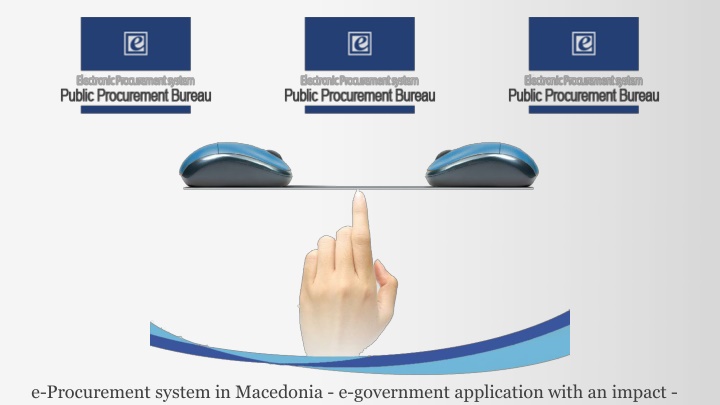



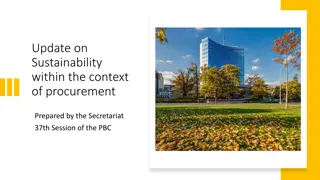
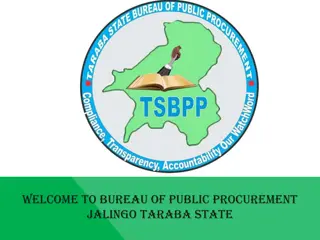
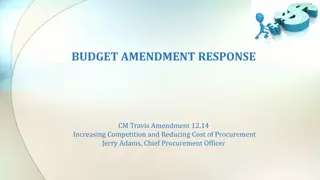
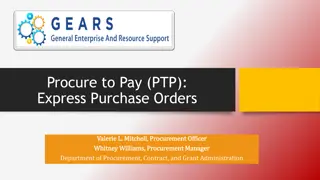
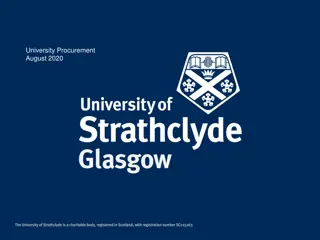
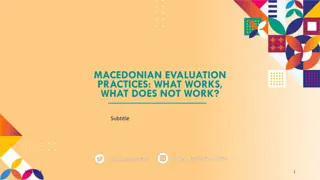
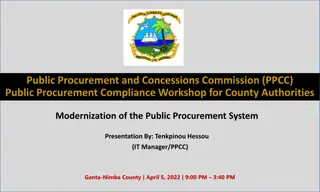
![Comprehensive Overview of Corruption Watch Submission on Public Procurement Bill [B18B-2023]](/thumb/138344/comprehensive-overview-of-corruption-watch-submission-on-public-procurement-bill-b18b-2023.jpg)
